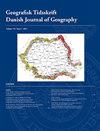地中海沙丘植被:保护西班牙南部受威胁的生态系统
IF 1.1
4区 社会学
Q4 ENVIRONMENTAL STUDIES
Geografisk Tidsskrift-Danish Journal of Geography
Pub Date : 2017-01-02
DOI:10.1080/00167223.2016.1267579
引用次数: 5
摘要
本文研究了位于西班牙南部Estepona的一个鲜为人知的受威胁沙丘复合体的植物多样性和植被现状。在过去60年中,这一沿海边缘地区经历了一个主要由旅游业和农业引起的密集占用的持续过程,这导致了脆弱和充满活力的沿海系统的退化。其规模的缩小和缺乏法律保护使其容易受到各种威胁该系统生存的人为压力的影响。鉴于以往研究的稀缺性,实地考察一直是进行研究的主要方法程序。研究结果首先提供了一个生物地理学和植物社会学的观点,阐明了研究地区显著的植物多样性和组成生态系统的完整的群落地带性结构。其次,绘制植物分布图(1:25 00),描绘植物区系的分布特征。这种植被的探索和测绘是形成保护建议的有效工具,以对抗破坏系统稳定的人为冲突。从这个意义上说,对沙丘形成的各种植被带的植物多样性构成威胁的有害人类活动也已被确定。本文章由计算机程序翻译,如有差异,请以英文原文为准。
Mediterranean dune vegetation: conservation of a threatened ecosystem in southern Spain
Abstract This paper investigates the plant diversity and current state of the vegetation of a little-known threatened dune complex located in Estepona (southern Spain). This littoral fringe has in the past 60 years experienced a continuous process of intensive occupation derived primarily from tourism and agriculture, which has led to the degradation of the fragile and dynamic coastal systems. Its diminished size and lack of legal protection make it vulnerable to a variety of anthropogenic stresses that threaten the survival of the system. Fieldwork has been the primary methodological procedure to conduct research, given the scarcity of previous studies. The results first of all provide a biogeographical and phytosociological view that elucidates the remarkable plant diversity of the area studied and the complete zonal structure of the communities that comprise the ecosystem. Secondly, a vegetal cartography was created (detail of 1: 2500) to characterize the distribution of flora. This exploration and mapping of vegetation are effective tools in forming a conservation proposal to combat anthropogenic conflicts that destabilize the system. In this sense, harmful human activities threatening the plant phytodiversity of the various strips of vegetation forming the dunes have also been identified.
求助全文
通过发布文献求助,成功后即可免费获取论文全文。
去求助
来源期刊
CiteScore
5.20
自引率
0.00%
发文量
5
期刊介绍:
DJG is an interdisciplinary, international journal that publishes peer reviewed research articles on all aspects of geography. Coverage includes such topics as human geography, physical geography, human-environment interactions, Earth Observation, and Geographical Information Science. DJG also welcomes articles which address geographical perspectives of e.g. environmental studies, development studies, planning, landscape ecology and sustainability science. In addition to full-length papers, DJG publishes research notes. The journal has two annual issues. Authors from all parts of the world working within geography or related fields are invited to publish their research in the journal.

 求助内容:
求助内容: 应助结果提醒方式:
应助结果提醒方式:


